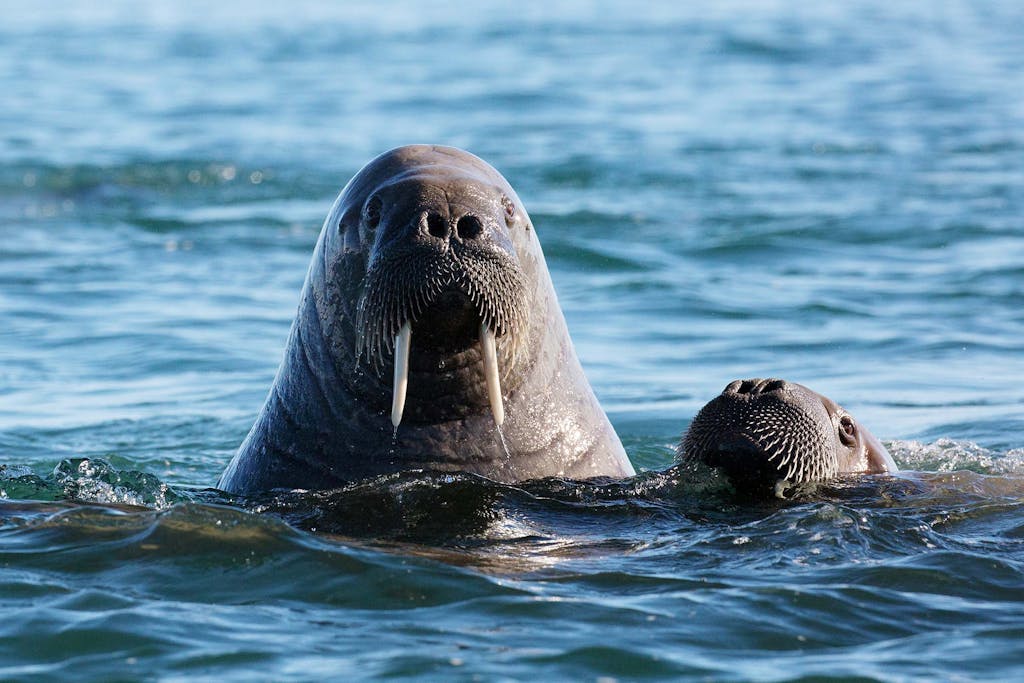Among Arctic Animals: The Magnificent and Endangered Atlantic Walrus
Life in the Arctic can feel surreal, unlike anything you’ve encountered. Especially when you spy on Arctic animals, such as the walrus. This almost prehistoric creature seems larger than life, with lengthy tusks and whispered lips.
Once, there were 20 species of walruses. But now, only two species are thought to remain — the Atlantic and the Pacific walrus. Aside from location, size is the primary difference between these cousins. On average, the Pacific walrus weighs more than 3,745 pounds (1,700 kilograms); the smaller Atlantic walrus comes in at 3,200 pounds (1,450 kilograms).
Having been around for millions of years — between 20 and 26 million — they have evolved to survive in unforgiving and constantly changing icy environments.
Home is where the ice is

The Arctic is a giant playground for these mammals. Like other Arctic animals, walruses live and die by the ice. The Atlantic walrus is mostly within the Arctic Circle in northern Canada and Northern Europe. During the winter months, they follow the edge of the ice south, while they spend their summers resting and foraging, also around the ice in the northern Arctic.
Although one might worry about their welfare in the harsh Arctic climate, they are more likely to overheat than be too cold. Thanks to a thick layer of blubber made of fats and collagen, walruses are well-equipped to handle the worst Mother Nature can throw at them.
“Walruses can thermoregulate by sending blood to the surface of their skin to cool down. That’s why they can change color from brownish red to a very pink color,” says Cory Ann Hom-Weaver, a Marine Biologist and Ecologist on Silversea voyages.
When you come across a herd of walruses hauled out on the beach on an Arctic cruise, you see various shades of brown (and a bit of pink) for miles. The loud honks, the smells and the sheer volume of the animals overwhelm.
They mostly prefer to rest on ice, but the ice recedes in summer, leaving only sandy beaches with sometimes thousands of same-sex walruses hauled out together. During breeding season, one bull can find himself with a harem of up to 20 cows.
The evolution of walruses’ tusks

Over millions of years, the walrus has evolved its canines into magnificent tusks. Their purpose is varied, but their importance to the animals’ survival is constant. They are used to help pull these enormous animals onto ice to rest, to maintain breathing holes in the ice and to fight with others when needed. Walruses are the only pinnipeds — a class of carnivorous marine mammals that includes true seals, eared seals and the walrus — that grow tusks. Both males and females have them.
“Walruses are still poached and hunted, as their [ivory] tusks can fetch a high price on black markets,” Hom-Weaver tells us. “They’re also used in customary carvings from villages in the remote Arctic regions of the world.”
This makes humans the walruses’ biggest threat and primary predator.
Polar bears and orcas are above the walrus on the food chain and occasionally hunt younger and more vulnerable walruses. But the sheer size of a walrus makes it difficult for those predators, causing them to expend too much energy trying to catch one.
A feast of oysters
“And all the little oysters stood and waited in a row,” Lewis Carroll wrote in his poem “The Walrus and the Carpenter.” It really is almost as if oysters (and other mollusks) lie in wait for the walruses to come swoop them up, as if to pay testament to the majesty of the animal.

To maintain their gargantuan size, these creatures enjoy a feast fit for Arctic royalty. “Walrus have a very specialized diet,” says Hom-Weaver. “They have capitalized on a food resource that no other pinniped has tapped into.” Their whiskers serve a special purpose: scouting for choice morsels on the seabeds. They dive up to 260 feet, and their whiskers help feel around for bivalves and invertebrates.
Thanks to a powerful jaw, their cheeks create a forceful suction that draws clams out of their shells.
Feasting on shellfish is a delicious tradeoff for living amid the harsh polar environment, but these endangered Arctic animals make the most of their surroundings — and delight expedition cruisers as they do.
Is a polar adventure on your bucket list? You can spy on walruses, beluga whales and more during a Silversea Expedition cruise to the Arctic & Greenland.
